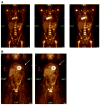Advances in time-of-flight PET
- PMID: 26778577
- PMCID: PMC4747834
- DOI: 10.1016/j.ejmp.2015.12.007
Advances in time-of-flight PET
Abstract
This paper provides a review and an update on time-of-flight PET imaging with a focus on PET instrumentation, ranging from hardware design to software algorithms. We first present a short introduction to PET, followed by a description of TOF PET imaging and its history from the early days. Next, we introduce the current state-of-art in TOF PET technology and briefly summarize the benefits of TOF PET imaging. This is followed by a discussion of the various technological advancements in hardware (scintillators, photo-sensors, electronics) and software (image reconstruction) that have led to the current widespread use of TOF PET technology, and future developments that have the potential for further improvements in the TOF imaging performance. We conclude with a discussion of some new research areas that have opened up in PET imaging as a result of having good system timing resolution, ranging from new algorithms for attenuation correction, through efficient system calibration techniques, to potential for new PET system designs.
Keywords: Image quality; Image reconstruction; PET; Photo-sensors; Scintillators; Time-of-flight PET.
Copyright © 2015 Associazione Italiana di Fisica Medica. Published by Elsevier Ltd. All rights reserved.
Figures




References
-
- Lewitt RM, Matej S. Overview of methods for image reconstruction from projections in emission computed tomography. Proc IEEE. 2003;91:1588–611.
-
- Snyder DL, Thomas LJ, Terpogossian MM. A mathematical model for positron emission tomography systems having time-of-flight measurements. IEEE Trans Nucl Sci. 1981;28:3575–83.
-
- Budinger TF. Time-of-flight positron emission tomography – status relative to conventional PET. J Nucl Med. 1983;24:73–6. - PubMed
-
- Tomitani T. Image reconstruction and noise evaluation in photon time-of-flight assisted positron emission tomography. IEEE Trans Nucl Sci. 1981;28:4582–9.
-
- Ter-Pogossian MM, Ficke DC, Hood JT, Sr, Yamamoto M, Mullani NA. PETT VI: a positron emission tomograph utilizing cesium fluoride scintillation detectors. J Comput Assist Tomogr. 1982;6:125–33. - PubMed
Publication types
MeSH terms
Grants and funding
LinkOut - more resources
Full Text Sources
Other Literature Sources

